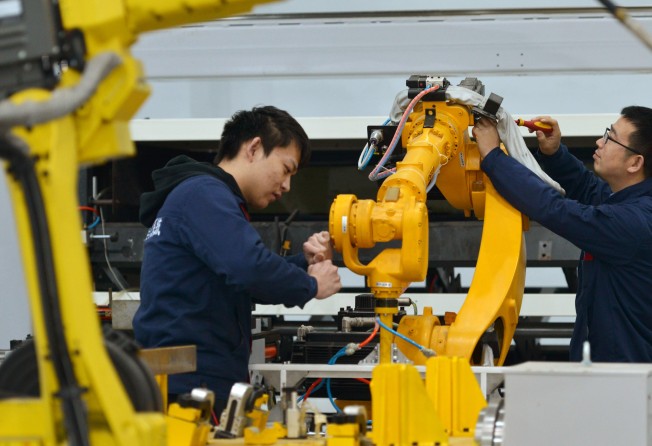China factory outlook darkens due weak domestic demand, but how will Beijing respond?
- The Caixin manufacturing purchasing managers’ index (PMI) dropped to a three-year low, with sector contraction deepening
- Trade deal between the administrations of President Xi Jinping and American counterpart Donald Trump seen as important to halt slowdown

The larger-than-expected deterioration in manufacturing sector activity in January paints a particularly grim picture of the Chinese economy, since much of the decline was due to weaker domestic demand, suggesting the government will have to do more to spur economic growth at home.
The Caixin manufacturing purchasing managers’ index (PMI) slumped to 48.3 in January from 49.7 in December, meaning Chinese manufacturing sector activity contracted for the second month in a row, and at a faster speed than the month before.
The index fell to its lowest since February 2016 and was below the 49.5 estimated by analysts.
Because of the Lunar New Year holiday, there is a vacuum of top-tier economic data in China during the first two months of each year, meaning the private Caixin survey is among the few indicators to show the condition of the world’s second largest economy at the beginning of 2019.
“With headwinds from cooling global growth and lagged impact of slower credit growth set to intensify, China’s economy is likely to weaken further over the coming months,” said economists from Capital Economics when commenting on the Caixin survey results.
The bleak Caixin PMI underscored how important it is for China and the United States to secure a trade deal soon, according to Robert Carnell, chief economist at ING.
Beijing said on Friday that American and Chinese negotiators had made “important progress” towards settling the trade war after their second day of talks in Washington ahead of the March 1 deadline.
But Zhong Zhengsheng, director of macroeconomic analysis at CEBM Group, a research organisation affiliated with Caixin, said that weakness in China’s manufacturing sector stemmed largely from muted domestic demand rather than from weak foreign trade.
“Domestic manufacturing demand shrank,” he said, noting that the overall orders subindex fell even though the export orders subindex rose.
“The output sub-index dropped in January, highlighting the drag effect of softer demand on production.
“External demand turned positive and became a bright spot amid positive progress in Sino-US trade talks.”
The slump in the Caixin index was somewhat at odds with the official manufacturing PMI released by the National Bureau of Statistics on Thursday, which improved slightly to 49.5 in January from 49.4 in December, although it remained below the 50.0 level that separates expansion from contraction.
Trinh Nguyen, senior economist at Natixis, said both the Caixin and official indicators showed the sector was contracting, the only difference was the pace of contraction.
“The official figure has more state-owned enterprises, which the government can push to do more to support the economy and is likely to do so in 2019,” she wrote on Twitter.
“The Caixin has more privately owned enterprises, so it was weaker.”
ING’s Carnell said that the deleveraging measures announced early last year continued to drag down the activities of private companies, while current government stimulus measures to stimulate lending to these companies seemed to be failing.
“This is not going to be an easy problem for the authorities to solve,” Carnell said. “As China has become larger, richer, and more complicated, it is becoming harder for the authorities to fix all problems by diktat.”
CEBM Group’s Zhong expects the government to launch more fiscal and monetary measures in the near future and speed up their implementation.
“Yet the stance of stabilising leverage and strict regulation hasn’t changed, which means the weakening trend of China’s economy will continue,” he said.
Note that Caixin & the official PMI say the same: manufacturing is CONTRACTING. The difference is the pace of contraction. The official figure has more SOEs, which the gov' can push to do more to support the economy & likely to do so in 2019. The Caixin has more POEs so weaker.
— Trinh (@Trinhnomics) February 1, 2019
The slowdown is also being felt across Asia with factory activity also shrinking in Taiwan, South Korea, Indonesia and Japan.
Taiwan posted its weakest readings since September 2015, South Korea the joint-lowest since November 2016 and Indonesia the first contraction in a year.
Japan’s factory activity was the slowest in 29 months, with weakening exports and output suggesting it could soon fall into contraction.
Manufacturers in the world’s third largest economy are facing both falling exports and a likely slump in domestic demand when the country’s sales tax is hiked in October.
Freight rates for dry-bulk and container ships, carriers of most of the world’s raw materials and finished goods, have plunged over the last six months.
The Baltic Dry Index, a measure of ship transport costs for materials like iron ore and coal, has fallen by 47 per cent since mid-2018, when the main trade tariffs were imposed.
“Other data out recently, not least Korea's trade figures for January, show that this is not just a China issue, but a regional one,” added ING’s Carnell.
Additional reporting by Reuters